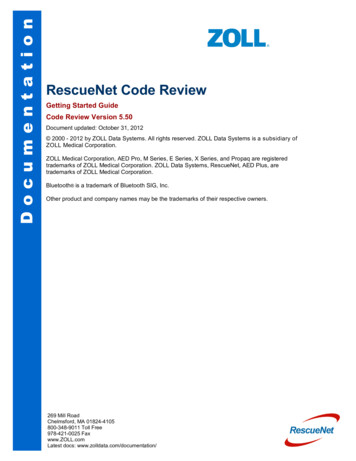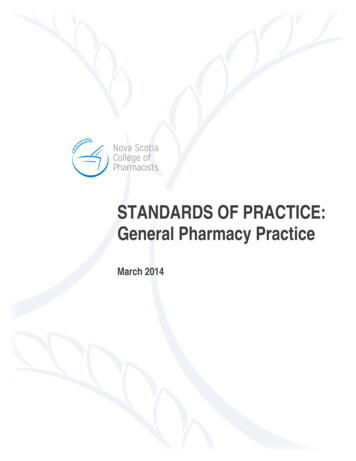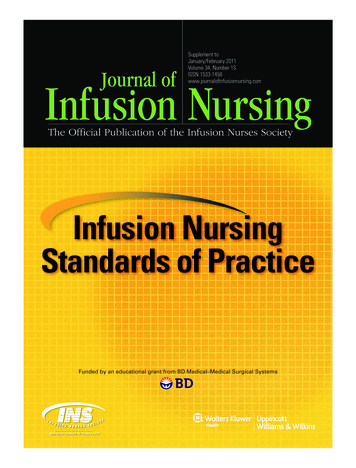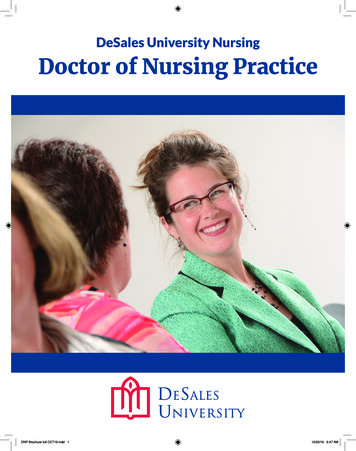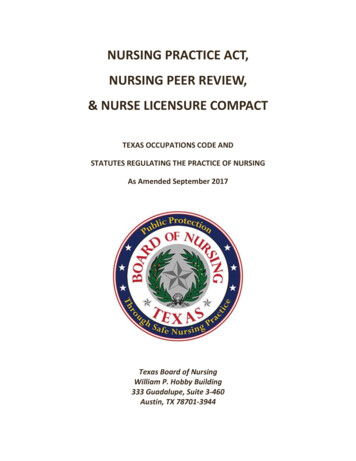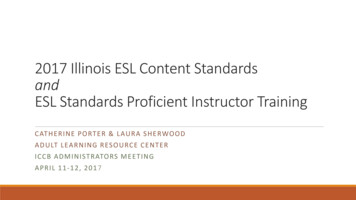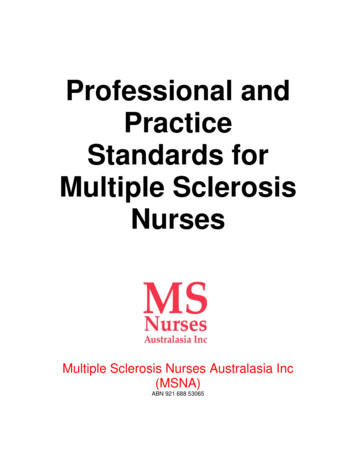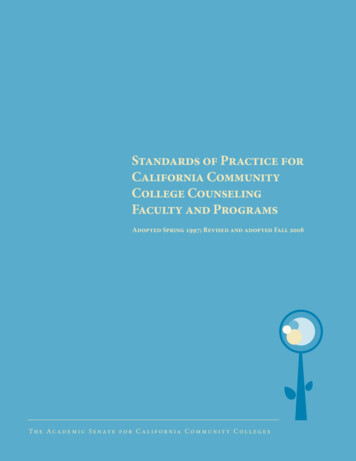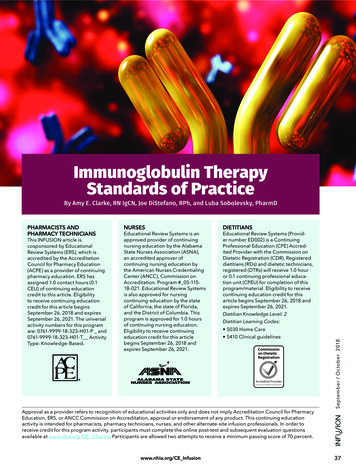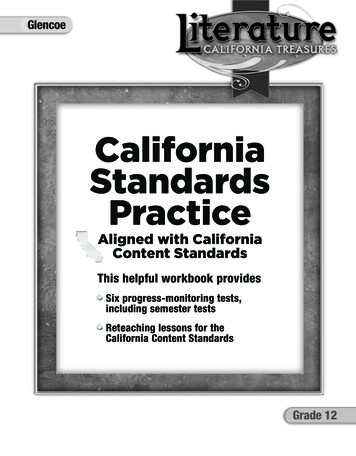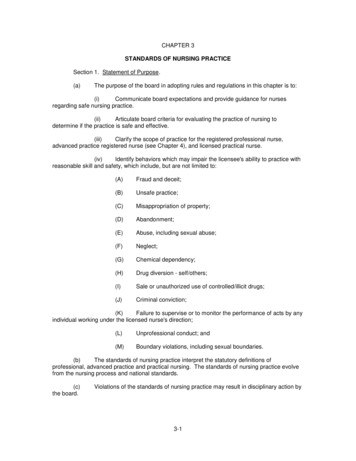
Transcription
CHAPTER 3STANDARDS OF NURSING PRACTICESection 1. Statement of Purpose.(a)The purpose of the board in adopting rules and regulations in this chapter is to:(i)Communicate board expectations and provide guidance for nursesregarding safe nursing practice.(ii)Articulate board criteria for evaluating the practice of nursing todetermine if the practice is safe and effective.(iii)Clarify the scope of practice for the registered professional nurse,advanced practice registered nurse (see Chapter 4), and licensed practical nurse.(iv)Identify behaviors which may impair the licensee's ability to practice withreasonable skill and safety, which include, but are not limited to:(A)Fraud and deceit;(B)Unsafe practice;(C)Misappropriation of property;(D)Abandonment;(E)Abuse, including sexual abuse;(F)Neglect;(G)Chemical dependency;(H)Drug diversion - self/others;(I)Sale or unauthorized use of controlled/illicit drugs;(J)Criminal conviction;(K)Failure to supervise or to monitor the performance of acts by anyindividual working under the licensed nurse's direction;(L)Unprofessional conduct; and(M)Boundary violations, including sexual boundaries.(b)The standards of nursing practice interpret the statutory definitions ofprofessional, advanced practice and practical nursing. The standards of nursing practice evolvefrom the nursing process and national standards.(c)the board.Violations of the standards of nursing practice may result in disciplinary action by3-1
Section 2. Standards of Nursing Practice for the Registered Professional Nurse(a)Accountability.(i)The registered professional nurse shall:(A)Have knowledge of the statutes and regulations governingnursing;(B)Practice within the legal boundaries for nursing through thescope of practice authorized in the Wyoming Nurse Practice Act and the board’s administrativerules and regulations;(C)Demonstrate honesty and integrity;(D)Base professional decisions on nursing knowledge and skills, theneeds of clients and the expectations delineated in professional standards;(E)Accept responsibility for judgments, individual nursing actions,competence, decisions and behavior;(F)Maintain continued competence through ongoing learning andapplication of knowledge to nursing practice;(G)Report unfit or incompetent nursing practice to recognized legalauthorities;(H)Participate in the development of continued competency in theperformance of nursing care activities for nursing personnel and students.(b)Implementation of the nursing process.(i)The registered professional nurse:(A)Conducts a comprehensive health assessment that is anextensive data collection (initial and ongoing) regarding individuals, families, groups, andcommunities.(I)Collecting objective and subjective data fromobservations, examinations, interviews, and written records in an accurate and timely manner.The data includes, but is not limited to:(1.)Biophysical and emotional status;(2.)Growth and development;(3.)Cultural, religious and socioeconomic(4.)Family health history;(5.)Information collected by other healthcare teambackground;members;3-2
(6.)Client knowledge and perception about currentor potential health status, or maintaining health status;(7.)Ability to perform activities of daily living;(8.)Patterns of coping and interacting;(9.)Considerations of client’s health goals;(10.)Environmental factors (e.g. physical, social,(11.)Available and accessible human and materialemotional, and ecological); andresources.(II)Sorting, selecting, reporting, and recording the data;(III)Validating, refining, and modifying the data by utilizingavailable resources including interactions with the client, family, significant others, and healthcareteam members.(B)the basis for the plan of care;Establishes and documents nursing diagnoses which serve as(C)Develops and modifies the plan of care based on nursingassessment and nursing diagnosis. This includes:(I)Identifying priorities in the plan of care;(II)Setting realistic and measurable goals to implement the(III)Identifying nursing interventions based on the nursingplan of care;diagnosis;(IV)Identifying measures to maintain comfort, supporthuman functions and responses, maintain an environment conducive to well being, and providehealth teaching and counseling.(D)Implements the plan of care by:(I)Initiating nursing interventions through:(1.)Giving direct care;(2.)Assisting with care;(3.)Delegating care as outlined in, but not limited to,Chapter 7, Section 6.(E)Identifies faulty or missing client information;(F)Provides appropriate decision making, critical thinking andclinical judgment to make independent nursing decisions and nursing diagnosis;3-3
(G)Seeks clarification of orders when needed;(H)Implements treatments and therapy, including medicationadministration and independent nursing functions;(I)Contributes to the formulation, interpretation, implementation,and evaluation of the objectives and policies related to nursing practice within the employmentsetting;(J)Participates in the evaluation of nursing practice through qualityassurance activities including peer review;(K)Obtains orientation/training for competence when encounteringnew equipment and technologies or unfamiliar care situations;(L)(M)appropriate interventions;Provides client surveillance and monitoring;Identifies changes in client’s health status and implements(N)Evaluates the impact of nursing care, the client’s response totherapy, the need for alternative interventions, and the need to communicate and consult withother healthcare team members;(O)Documents nursing care and responses to interventions;(P)Intervenes on behalf of the client when problems are identifiedand revises care plan as needed;(Q)Recognizes individual characteristics that may affect the client’s(R)Takes preventive measures to protect the client, others, and self.health status;(ii)Advocates for the client.(A)Respects the client’s rights, concerns, decisions, and dignity;(B)Identifies client needs;(C)Accepts only client care assignments for which educationallyprepared and adequately trained;(D)Promotes safe client environment;(E)Communicates client choices, concerns, and special needs withother healthcare team members regarding:(I)Client status, progress, and concerns;(II)Client response or lack of response to therapies;(III)Significant changes in client condition.3-4
(F)Maintains appropriate professional boundaries, including sexual(G)Maintains client confidentiality unless obligated by law to(H)Assumes responsibility for own decisions and actions;boundaries;disclose the information;(I)Conducts practice without discrimination on the basis of age,race, religion, sex, life style, national origin, medical diagnosis, or handicap.(iii)Organizes, manages, and supervises the practice of nursing.(A)Assigns to another only those nursing measures that fall withinthat nurse’s scope of practice, education, experience, and competence or unlicensed personsdescription;(B)Delegates to another only those nursing measures that theperson has the necessary education, skills, and competency to accomplish safely and as outlinedin Chapter 9;(C)Matches client needs with personnel qualifications, availableresources and appropriate supervision;(D)Communicates directions and expectations for completion of thedelegated activity;(E)Supervises others to whom nursing activities are delegated orassigned by monitoring performance, progress, and outcomes; and ensures documentation of theactivities;(F)Provides follow-up on problems and intervenes when needed;(G)Evaluates the effectiveness of the delegation or assignment;(H)Evaluates data as a basis for reassessing client’s health status,modifying nursing diagnoses, revising plans of care, and determining changes in nursinginterventions;(I)Retains professional accountability for nursing care;(J)Promotes a safe and therapeutic environment by:(I)Providing appropriate monitoring and surveillance of the(II)Identifying unsafe care situations;care environment;(III)Correcting unsafe care situations or referring unsafecare situations to appropriate management level when needed.3-5
(K)Teaches and counsels client and families regarding healthcareregimen, which may include, but is not limited to, general information about health and medicalcondition, specific procedures, wellness, and prevention;(iv)Participates as a member of an interdisciplinary healthcare team.(A)Functions as a member of the healthcare team, collaboratingand cooperating in the implementation of an integrated, client-centered healthcare plan;(B)Respects client property and the property of others;(C)Protects confidential information, unless obligated by law todisclose the information.Section 3. Standards of Nursing Practice for the Licensed Practical Nurse(a)process.Standards related to the licensed practical nurse's contribution to the nursing(i)The licensed practical nurse shall:(A)Contribute to the nursing assessment by:(I)Collecting, reporting, and recording objective andsubjective data in an accurate and timely manner. Data collection includes observations about thecondition or change in condition of the client.(B)Participate in the development and modification of the plan ofcare by:(I)Providing data;(II)Contributing to the identification of priorities;(III)Contributing to setting realistic and measurable goals;(IV)Assisting in the identification of measures to maintaincomfort, support human functions and responses, maintain an environment conducive to wellbeing, and provide health teaching and counseling; and(V)Basing nursing decisions on nursing knowledge, skills,and needs of clients.(C)Participate in the implementation of the plan of care by:(I)Carrying out such interventions as are taught in boardapproved curriculum for practical nurses and as allowed by institutional policies;(II)Providing care for clients in basic patient care situationsunder the direction of a licensed physician, dentist, advanced practice registered nurse, orlicensed professional nurse. Patient care situations as determined by a licensed physician,dentist, advanced practice registered nurse, or licensed professional nurse mean the followingtwo (2) conditions prevail at the same time:3-6
(1.)The client's clinical condition is predictable andthe responses of the client to the nursing care are predictable;(2.)Medical or nursing orders do not changefrequently and do not contain complex modifications.(III)Providing care for clients in complex patient caresituations under the supervision of a licensed physician, dentist, advanced practice registerednurse, or licensed professional nurse. Complex patient care situations as determined by alicensed physician, dentist, advanced practice registered nurse, or licensed professional nursemean any one or more of the following conditions exist:(1.)(2.)frequent changes or complex modifications; orThe client's clinical condition is not predictable;Medical or nursing orders are likely to involve(3.)The client's clinical condition indicates care thatis likely to require modification of nursing procedures in which the responses to the nursing careare not predictable.(IV)Initiating appropriate standard emergency proceduresestablished by the institution until a licensed physician, dentist, advanced practice registerednurse or registered professional nurse is available;(V)Providing an environment conducive to safety and(VI)Documenting nursing interventions and responses tohealth;care;(VII)Communicating nursing interventions and responses tocare to appropriate members of the healthcare team.(D)Contribute to the evaluation of the responses of individuals orgroups to nursing interventions by:(I)Documenting evaluation data and communicating thedata to appropriate members of the healthcare team;(II)Contributing to the modification of the plan on the basisof the evaluation.(b)Standards relating to the licensed practical nurse's responsibilities as a memberof the healthcare team.(i)The licensed practical nurse shall:(A)Have knowledge of the statutes and regulations governingnursing;(B)actions and competency;Accept individual responsibility and accountability for nursing3-7
(C)Function under the direction of a licensed physician, advancedpractice registered nurse, dentist, or registered professional nurse;(D)Seek guidance and consult with registered professional nursesand other appropriate sources;(E)Obtain direction and supervision as necessary whenimplementing nursing interventions;(F)Accept client care assignments from the licensed physician,advanced practice registered nurse, dentist, or registered professional nurse only for which theyare educationally prepared and adequately trained;(G)Function as a member of the healthcare team;(H)Contribute to the formulation, interpretation, implementation, andevaluation of the objectives and policies relating to practical nursing practice within theemployment setting;(I)Participate in the evaluation of nursing practice through qualityassurance activities, including peer review;(J)Report unfit or incompetent nursing practice to the board.Report unsafe conditions for practice to recognized legal authorities;(K)Delegate to another only those nursing interventions which aperson is prepared or qualified to perform;(L)Provide direction for others to whom nursing interventions are(M)performed under direction;Evaluate the effectiveness of delegated nursing interventions(N)interventions. See Chapter 9;Retain accountability for nursing care when delegating nursingdelegated;(O)Conduct practice without discrimination on the basis of age,race, religion, sex, life-style, national origin, or disability;(P)Respect the dignity and rights of clients and their significantothers, regardless of social or economic status, personal attributes, or nature of health problems;(Q)Protect confidential information, unless obligated by law to(R)Respect the property of all individuals and facilities;(S)Maintain boundaries, including sexual boundaries;disclose the information;(T)Participate in the development of continued competency inperformance of nursing care activities for auxiliary personnel;3-8
CHAPTER 9DELEGATION AND ASSIGNMENTSection 1.(a)Statement of PurposeThe purpose of the board in adopting rules and regulations in this chapter is:(i)To establish acceptable standards of safe delegation of nursing tasks.(ii)To provide criteria for the board to evaluate safe and competentdelegation of nursing tasks.Section 2.(a)Definitions“Authority” means the source of the power to act.(b)“Delegation” is transferring to a competent individual the authority to perform aspecific nursing task in a selected situation. The nurse retains the responsibility and theaccountability for the delegated tasks.(c)“Assignment” is the performance of designated nursing activities/tasks by alicensed nurse or certified nursing assistant that are consistent with the scope of practice of alicensed nurse or the role description of a certified nursing assistant; the distribution of work thateach staff member is responsible for during a given work period.(d)“Evaluation” is the final and critical step of delegation; to review the nursing careprovided, the effectiveness of the nursing interventions and the need to change any part of theplan of care in order to better meet patient needs.Section 3.Principles of Delegation(a)All decisions related to delegation and assignment are based on the fundamentalprinciples of protection of the health, safety and welfare of the public (the statements in Section 3are directly from the Joint Statement on Delegation, American Nurses Association and theNational Council of State Boards of Nursing, 2006).(i)The registered nurse takes responsibility and accountability for theprovision of nursing practice.(ii)The registered nurse directs care and determines the appropriateutilization of any nursing assistant involved in providing direct patient care.(iii)The registered nurse may delegate components of care but does notdelegate the nursing process itself. The functions of assessment, planning, evaluation andnursing judgment are pervasive to nursing practice and cannot be delegated.(iv)The decision of whether or not to delegate or assign is based upon theregistered nurse’s judgment concerning the condition of the patient, the competence of membersof the nursing team and the degree of supervision that will be required of the registered nurse if atask is delegated.(v)The registered nurse delegates only those tasks for which she or hebelieves the other health care worker has the knowledge and skill to perform, taking intoconsideration training, cultural competence, experience and facility/agency policies and9-1
procedures.(vi)The registered nurse individualizes communication regarding thedelegation to the nursing assistant and client situation. The communication should be clear,concise, correct and complete. The registered nurse verifies comprehension with the nursingassistant and that the nursing assistan accepts the delegation and the responsibility thataccompanies it.(vii)Communication must be a two-way process. Nursing assistants musthave the opportunity to ask questions and/or for clarification of expectations.(viii)The registered nurse uses critical thinking and professional judgmentwhen following the five rights of delegation:(A)The right task;(B)Under the right circumstances;(C)To the right person;(D)With the right directions and communication; and(E)Under the right supervision and evaluation.(b)Chief nursing officers are accountable for establishing systems to assess,monitor, verify and communicate ongoing competence requirements in areas related todelegation (Joint Statement on Delegation, American Nurses Association and the NationalCouncil of State Boards of Nursing, 2006, pg 2).Section 4.(a)AccountabilityThe delegating licensed nurse retains accountability for:(i)ensure patient safety;Nursing care when delegating nursing tasks or interventions to(ii)The decision to delegate;(iii)Verifying the delegatee’s competency to perform the tasks;(iv)Providing direction or supervision;(v)The performance of the delegated task;(vi)Evaluating the effectiveness of the delegated nursing task orinterventions performed under direction or supervision.Section 5.Standard for Delegation of Basic Nursing Tasks and Skills(a)The licensed nurse delegates tasks based on the needs and condition of thepatient, potential for harm, stability of the patient’s condition, complexity of the task, predictabilityof the outcomes, ability of the staff to whom the task is delegated , and the context of otherpatient needs.(b)Nursing assistant may complement the licensed nurse in the performance of9-2
nursing functions but shall not substitute for the licensed nurse.(c)Delegation shall be task-specific, client-specific, and nursing assistant specific.(d)The standards of nursing assistant practice evolve from the performance ofdelegated nursing related tasks and services regardless of an individual's title or care setting.(e)The delegator shall be a licensed nurse.(i)When delegating a nursing task, the delegator shall:(A)before delegating the task;(B)Make an initial assessment of the client's nursing care needsVerify the nursing assistant’s competence to perform any nursingtask prior to delegation;(C)Verify appropriate continuing education for each nursingassistant for each task to be performed;(D)Communicate with nursing assistant allowing the opportunity toask questions, provide feedback, or clarification;(E)Inform the patient/client of the decision to delegate;(F)Provide appropriate direction or supervision;(G)Remain accountable for the delegated tasks;(H)Evaluate client outcomes and make adjustments accordingly;(I)Make clear to the nursing assistant that the delegated taskandcannot be re-delegated.(I)Delegation is unnecessary if the particular activity or taskis already within the legally recognized scope of practice of the individual (delegate) who is toperform the activity or
nurse, or licensed professional nurse. Complex patient care situations as determined by a licensed physician, dentist, advanced practice registered nurse, or licensed professional nurse mean any one or more of the following conditions exist: (1.) The client's clinical condition is not predictable; (2.) Medical or nursing orders are likely to .
